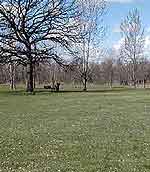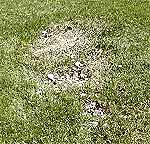By Dan Gunderson and Chris Julin
Minnesota Public Radio
July 29, 2002
| |
|
|
|
||
On a summer day, you can watch packs of kids race across the grass in Trollwood Park, along the Red River in Fargo. The kids don't know they're playing on graves.
Jeanette Stanton knows. She was a county commissioner about 20 years ago when the county board voted to mark these graves. Now, she says, it looks as if the agreement has been forgotten.
"They were people who didn't have friends or family," she says of the people buried here. "Maybe nobody knew them. So who cared? And that's sad, just really sad."
The county poorhouse was called Golden Acres, and it used to be just up the hill. The unmarked graves are all that's left. There might be 1,000 poor people buried here, but there's only one clue. On the far edge of the park, where not many people see it, there's a big rock that's engraved with the words: "County Cemetery Number 2."
Jeanette Stanton says this burial ground deserves more.
"There is absolutely no doubt in my mind that it should get a good-sized marker that people are going to stop and look at, and think about the people who are buried here," she says.
Historians have a list of the people buried here. The graves might have been marked with wooden crosses at one time, but those disappeared decades ago. Now, it takes a trained eye to find the rows of graves.
| |
|
|
|
||
"Here's an aging grave here," says Lowell Brenna, pointing to a barely noticeable depression in the Trollwood Park grass. "There's probably another one. There's probably another one."
Lowell Brenna has dug up more than 100 bodies in this park. That was about 20 years ago when we was studying to be a mortician in college.
He was hired to move graves because the Red River had cut into edge of the park and exposed coffins and bones.
"We don't know who those people were and we don't know their stories, and maybe we should," says Brenna. "Should there be a huge and beautiful monument to remind the community? I think that would be way over and above what any of these people dreamed of."
But Brenna says there should be some sort of visible monument for the people buried here.
"I think we need to acknowledge this is what it is," he says. "And I don't think that's a scary thing."
Across the country, thousands of people were buried in unmarked graves at poorhouses. A few of those graves are marked, now. That's usually the work of a persistent relative.
Next: The search for family members


